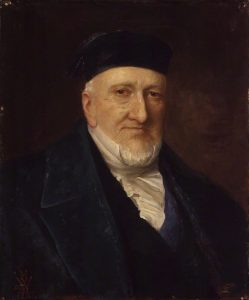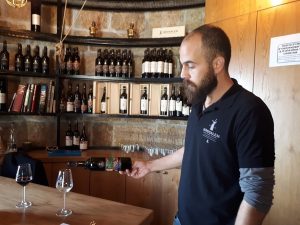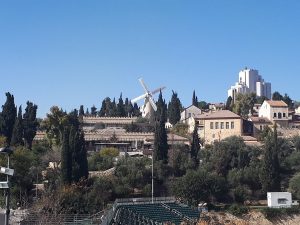Landmark structure just outside of the Old City reincarnates itself as a wine and visitors’ center following extensive renovations
When British-Jewish philanthropist Sir Moses Montefiore purchased a plot of land near Jerusalem’s Old City in the mid-19th century, he helped sow the seeds of the first Jewish neighborhood built outside the historic Ottoman-era walls.

A painting by Henry Weigall (1881) depicting Sir Moses Montefiore. (Wikimedia Commons)
In the hopes of encouraging self-sufficiency and lifting the local Jewish population out of poverty, he also spearheaded the construction of a traditional Dutch windmill for the production of flour.
The adjacent Jewish neighborhood, also financed by Montefiore and named Mishkenot Sha’ananim (dwellings of tranquility), grew even as the windmill ceased to serve its original purpose. For most of the 20th century, the prominent monument lay idle, in a state of disrepair, its doors locked.
Roughly 150 years later, the long-neglected structure—with its massive stone walls and narrow windows—has been reborn after years of extensive renovation. It still does not grind wheat; rather, it now serves as a hub for tourists and visitors wishing to partake of wine tastings and attend workshops provided by Jerusalem Vineyard Winery.
“The Jerusalem Winery is the only winery located geographically in Jerusalem,” Jamie Sellouk, one of Israel’s top sommeliers who runs the wine tasting and visitors’ center, told The Media Line. “We produce around 1.5 million bottles per year and we’re working with the Jerusalem Foundation to revivify the area.” Sellouk noted that a Dutch windmill expert was brought in to help with the recent restoration efforts. In addition, new machinery manufactured in the Netherlands and based on the original 19th-century designs was shipped to Israel.

Sommelier Jamie Sellouk pours wine inside the Montefiore Windmill. (Photo: The Media Line/Maya Margit)
“In 2012, the Dutch organization Christians For Israel partnered with the Jerusalem Foundation to rebuild the windmill,” he explained. “This is an accurate reconstruction of the mill. At the time when it broke down, steam mills were already a technology available in Jerusalem so there was no financial interest in renovating it.”
Sellouk describes the site as a “piece of living history.” During the 1948 War of Independence, Jewish fighters used it as an observation post, a move the British attempted to neutralize. In fact, in an episode reminiscent of Miguel de Cervantes’ Don Quixote, British soldiers tasked with destroying the monument blew up the top of the tower, thankfully leaving the rest of the structure intact.
In the 1970s, the windmill opened to the public as a museum narrating the life and achievements of Sir Moses Montefiore.

A view of the Montefiore Windmill and surrounding Mishkenot Sha’ananim neighborhood in Jerusalem. (Photo: The Media Line/Maya Margit)
Though there were hopes the windmill would return to its roots as an operational flour mill following the renovations, it has yet to receive approval from Israel’s Health Ministry. According to Sellouk, the government body argued that the structure does not meet modern standards of industrial flour factories. “The wheat grown in Israel is also apparently significantly harder than what’s called ‘European wheat,’ so it’s much more difficult for the millstone to grind it,” Sellouk asserted. “We also don’t have access to wind all the time.”
Aside from the visitors’ center on the bottom floor, local artist Netanel Morhan has been tasked with operating the sails on a daily basis and maintaining the windmill. Activating the sails is no simple feat as it involves climbing up the old-fashioned structure’s steep ladders and walking along narrow wooden planks, which are located perilously close to huge moving wooden cogwheels.
“If I make one wrong move with my feet, I will fall down and get crushed beneath the cogwheels,” Morhan explained to The Media Line with a sardonic grin, recounting how on one occasion he tripped on his shoelace and nearly fell between the rotating gears.
Despite this apparent danger, the windmill has special significance to Morhan, who views it as a symbol of the renewal of Zion.
“This was the first time that Jews would really start to work with their own hands in order to become self-sufficient,” he stressed. “Before this, many Jews only learned the Torah [Old Testament] and resided inside the Old City walls for 2,000 years.”